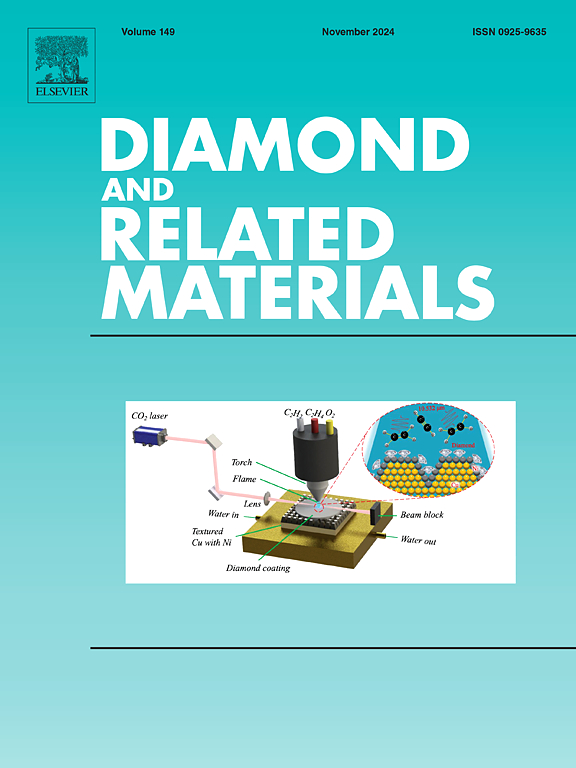Cu(OH)2 和碳纳米管电极的原位合成:有望实现高性能一维柔性超级电容器的方法
IF 4.3
3区 材料科学
Q2 MATERIALS SCIENCE, COATINGS & FILMS
引用次数: 0
摘要
随着电气设备使用率的快速增长,人们迫切需要先进的电源解决方案。柔性超级电容器以其卓越的电化学特性而闻名,是一种前景广阔的解决方案。本研究利用铜线(CW)原位技术获得了两个电极的活性材料。正极 CW@Cu(OH)2 电极是通过 CW 和 NH3-H2O 的气相反应合成的,通过碱辅助氧化过程生成氢氧化铜(Cu(OH)2)纳米片。在不同反应条件下对 CW@Cu(OH)2 电极进行的比较分析表明,Cu(OH)2 纳米片的特点是尺寸小、在 CW 上的分布密度高,能显著提高电化学性能。优化后的 CW@Cu(OH)2 电极的比电容达到了 195.7 mF cm-2。这种原位生长方法可有效防止活性材料脱落,从而使电极的内阻最小。碳纳米管(CNT)也是通过化学气相沉积在 CW 上原位合成的,用作负极的活性材料。并联组装的柔性超级电容器(CW@Cu(OH)2//KOH-PVA//CW@CNTs)在电流密度为 0.1 A cm-3 时的比电容为 1.59 F cm-3,在功率密度为 15 mW cm-3 时的能量密度为 0.496 mWh cm-3。这种超级电容器在不同的电流密度和不同的弯曲角度下都能保持稳定的电容,是一种多功能、稳定的电力存储解决方案。本文章由计算机程序翻译,如有差异,请以英文原文为准。

In situ synthesis of Cu(OH)2 and carbon nanotube electrodes: A promising approach for high-performance one-dimensional flexible supercapacitors
Amidst the rapid surge in electrical device utilization, there is an urgent need for advanced power supply solutions. Flexible supercapacitors, renowned for their remarkable electrochemical properties, emerge as a promising remedy. This study employs in situ techniques on copper wire (CW) to obtain active materials for both the electrodes. The positive CW@Cu(OH)2 electrode, synthesized through vapor-phase reaction between CW and NH3·H2O, yields copper hydroxide (Cu(OH)2) nanosheets via an alkali-assisted oxidation process. Comparative analysis of CW@Cu(OH)2 electrodes under varying reaction conditions revealed that the Cu(OH)2 nanosheets, characterized by their small size and high distribution density on CW, significantly enhance electrochemical performance. The optimized CW@Cu(OH)2 electrode achieved a specific capacitance of 195.7 mF cm−2. This in situ growth method effectively prevents active material detachment, resulting in electrodes with minimal internal resistance. Carbon nanotubes (CNTs), also synthesized in situ via chemical vapor deposition on CW, serve as the active materials for the negative electrode. Assembled in parallel, the flexible supercapacitor, CW@Cu(OH)2//KOH-PVA//CW@CNTs, achieves a specific capacitance of 1.59 F cm−3 at a current density of 0.1 A cm−3, with an energy density of 0.496 mWh cm−3 at a power density of 15 mW cm−3. Demonstrating robust capacitance retention across varying current densities and diverse bending angles, this supercapacitor signifies a versatile and stable power storage solution.
求助全文
通过发布文献求助,成功后即可免费获取论文全文。
去求助
来源期刊

Diamond and Related Materials
工程技术-材料科学:综合
CiteScore
6.00
自引率
14.60%
发文量
702
审稿时长
2.1 months
期刊介绍:
DRM is a leading international journal that publishes new fundamental and applied research on all forms of diamond, the integration of diamond with other advanced materials and development of technologies exploiting diamond. The synthesis, characterization and processing of single crystal diamond, polycrystalline films, nanodiamond powders and heterostructures with other advanced materials are encouraged topics for technical and review articles. In addition to diamond, the journal publishes manuscripts on the synthesis, characterization and application of other related materials including diamond-like carbons, carbon nanotubes, graphene, and boron and carbon nitrides. Articles are sought on the chemical functionalization of diamond and related materials as well as their use in electrochemistry, energy storage and conversion, chemical and biological sensing, imaging, thermal management, photonic and quantum applications, electron emission and electronic devices.
The International Conference on Diamond and Carbon Materials has evolved into the largest and most well attended forum in the field of diamond, providing a forum to showcase the latest results in the science and technology of diamond and other carbon materials such as carbon nanotubes, graphene, and diamond-like carbon. Run annually in association with Diamond and Related Materials the conference provides junior and established researchers the opportunity to exchange the latest results ranging from fundamental physical and chemical concepts to applied research focusing on the next generation carbon-based devices.
 求助内容:
求助内容: 应助结果提醒方式:
应助结果提醒方式:


